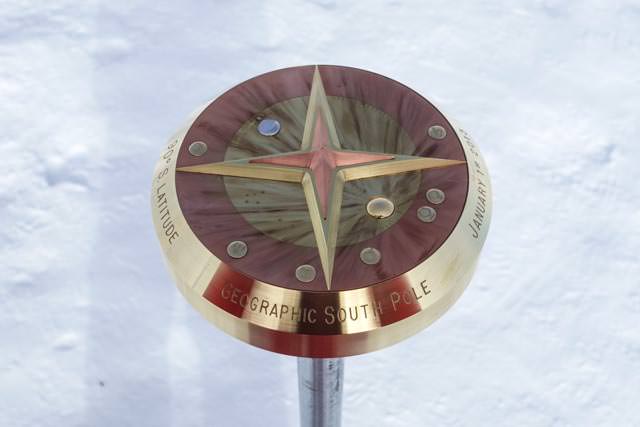The new geographic South Pole marker that stands at 90º S latitude. (Credit: Jeffrey Donenfeld)
Because the Amundsen-Scott South Pole Station sits atop a layer of moving ice almost 2 miles thick, the location of the marker for the Earth’s geographic South Pole needs to be relocated regularly. Tradition has this done on New Year’s Day, and so this past January 1 saw the unveiling of the newest South Pole marker: a beautiful brass-and-copper design created by Station machinist Derek Aboltins.
 The top of the marker has seven small discs that represent the planets in the positions they would be in on Jan. 1, 2013, as well as two larger discs representing the setting Sun and Moon. Next to the Moon disc are the engraved words “Accomplishment & Modesty,” a nod to the first man on the Moon.
The top of the marker has seven small discs that represent the planets in the positions they would be in on Jan. 1, 2013, as well as two larger discs representing the setting Sun and Moon. Next to the Moon disc are the engraved words “Accomplishment & Modesty,” a nod to the first man on the Moon.
“This was a reference to honor Neil Armstrong, as he passed away when I was making this section with the moon,” Aboltins said.
And for folks who might think the planet count on the new marker is one too few, a surprise has been tucked away on the reverse side.
“For those of you who still think Pluto should be a planet, you’ll find it included underneath, just to keep everyone happy,” Aboltins said. “Bring back Pluto, I say!”
And so, on the underside of the marker along with the signatures of South Pole Station researchers and workers, is one more disc — just for the distant “demoted” dwarf planet.
Underside of the South Pole marker (Credit: Jeffrey Donenfeld)
“For those of you who still think Pluto should be a planet, you’ll find it included underneath, just to keep everyone happy!”
– Derek Aboltins, designer and machinist
(See high resolution versions of these images here.)
The marker was placed during a ceremony on the ice on Jan. 1, during which time the previous flag marker was removed and put into its new position.
(Photo credit: Jeffrey Donenfeld)
According to The Antarctic Sun:
“Almost all hands were present for the ceremony, including station manager Bill Coughran, winter site manager Weeks Heist, and National Science Foundation representative Vladimir Papitashvili. The weather was sunny and a warm at just below minus 14 degrees Fahrenheit.”
(Even though it’s mid-summer in Antarctica, “warm” is clearly a relative term!)
Read more about this and other Antarctic news on The Antarctic Sun site, and see more photos from Antarctica by Jeffrey Donenfeld here.
_____________________
Named for explorers Roald Amundsen and Robert F. Scott, who attained the South Pole in 1911 and 1912, the Amundsen-Scott South Pole Station stands at an elevation of 2,835 meters (9,306 feet) on Antarctica’s ice sheet, which is about 2,700 meters (9,000 feet) thick at that location. The station drifts with the ice sheet at about 10 meters (33 feet) each year. Research is conducted at the station in the fields of astronomy, astrophysics, glaciology, geophysics and seismology, ocean and climate systems, biology, and medicine.




“And for folks who might think the planet count on the new marker is one
too few, a surprise has been tucked away on the reverse side.”
I still think 7 planets are 1 too few. Shouldn’t there be 8 planets? Pluto was the 9th planet.
There isn’t a disc for Earth on this marker. That’s your missing planet.
Bingo.
Ah. Thank you. Wasn’t getting it. Makes sense though.
Pluto IS still a planet, and kudos to Aboltins for including it. Dwarf planets are planets too, which makes Pluto the solar system’s 10th planet out of 13 and counting: Mercury, Venus, Earth, Mars, Ceres, Jupiter, Saturn, Uranus, Neptune, Pluto, Haumea, Makemake, and Eris.
I see that you, too, have Alan Stern type views.
Really, people make it out that dwarf planets are as common as asteroids – not the case. We know of 5 in the Solar System, 3 of which are not even dwarf planets for sure.
Just because there are many planets, does this make them any less special? When more than 9 galaxies were discovered, does this make a galaxy any less meaningful?
In honor of Mr. Neil Armstrong, on a South Pole marker inscribed, “Accomplishment & Modesty”: anchored on an Antarctic field of glittering ice, an inscription reflecting one trait of true greatness.
From soil of humble farmland birth, he made his journey on, “as the bird that migrates” far, and found flight on sea-wings of aviation, under constellations of northern Star. From years riding the clouds on many a designed form of man, he rose above the World of land, as “on wings of an Eagle lifted through the skies”, in company of a chosen few. Ascended with thunderous roar, from thrusting flames they soared. And, through quiet passage of starry night, journeyed on to momentous landfall of epic flight. Upon an unearthly shore they came, as humanity paused from their trouble and gain, and listened with bated breath – the signal of an Eagle’s off-World success! Closely, they watched for a commanders hail, as one small step was taken for man – onto the Moon’s surface dust to unveil!
Arrived back to arch of triumph, an avenue of celebrated procession lay open before him, and inviting chariot wreathed in vainglory: Spotlight of fame was his for the taking, fortune of name for the grasping. In surging wake of a successful voyage to “the Sea of Tranquility”, all that was one small mounting-step away. (As one did say.)
From Sunlit brilliance of Lunar Plain, – in whose blackest night of dream, Planet Earth hung suspended as by vision seen – in company he returned, one giant leap made, for all mankind attained. Yet, from beckoning podiums of public glory, made one big manly step back behind curtain of humility – and, rather turned to acknowledge all, upon whose shoulders, a heroic band were able to rise on Apollo’s fire. From that pinnacle height he progressed a life of distinguished service, strewn with laurel honors.
Now, where Emperors reign under emerald curtains of Polar sky, and ruby ribbons garland the long celestial night, carved into a fine-crafted work, word of honor bestowed on one man who, having taken his final step from the shadows of distinguished accomplishment, enters the crystal hall of greatness.
Added to many a decoration from 17 countries, from life-path strewn with special honors, his memory now memorialized at the heart of The Southern Continent, “above the world to see”.
Where constellations of splendor turn to seasons of night, and Winter unfolds the elegant dance of auroral light!